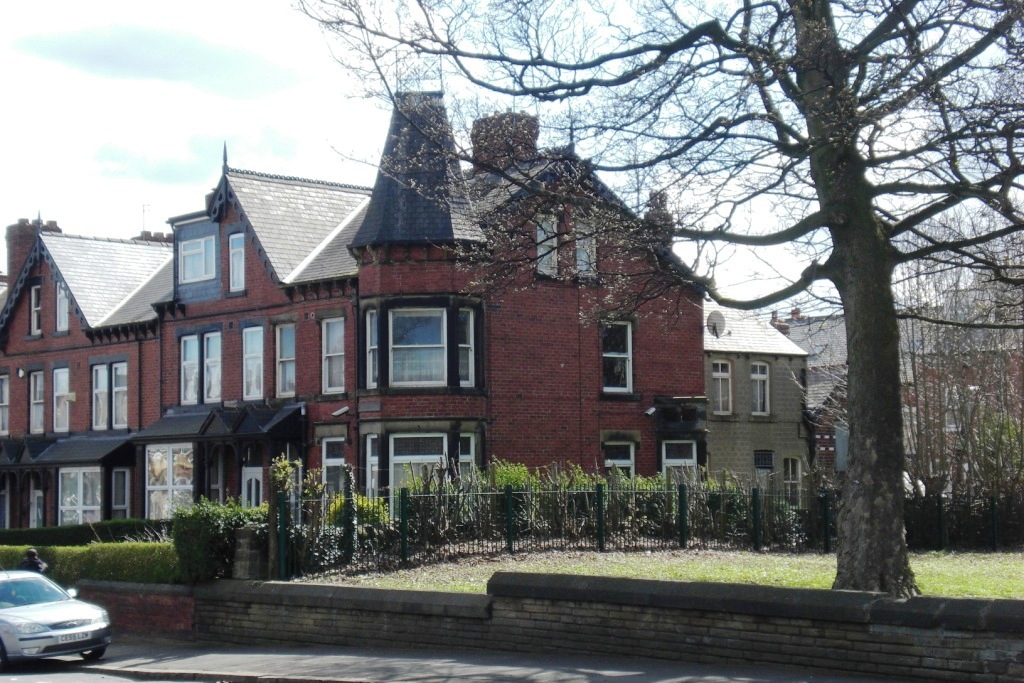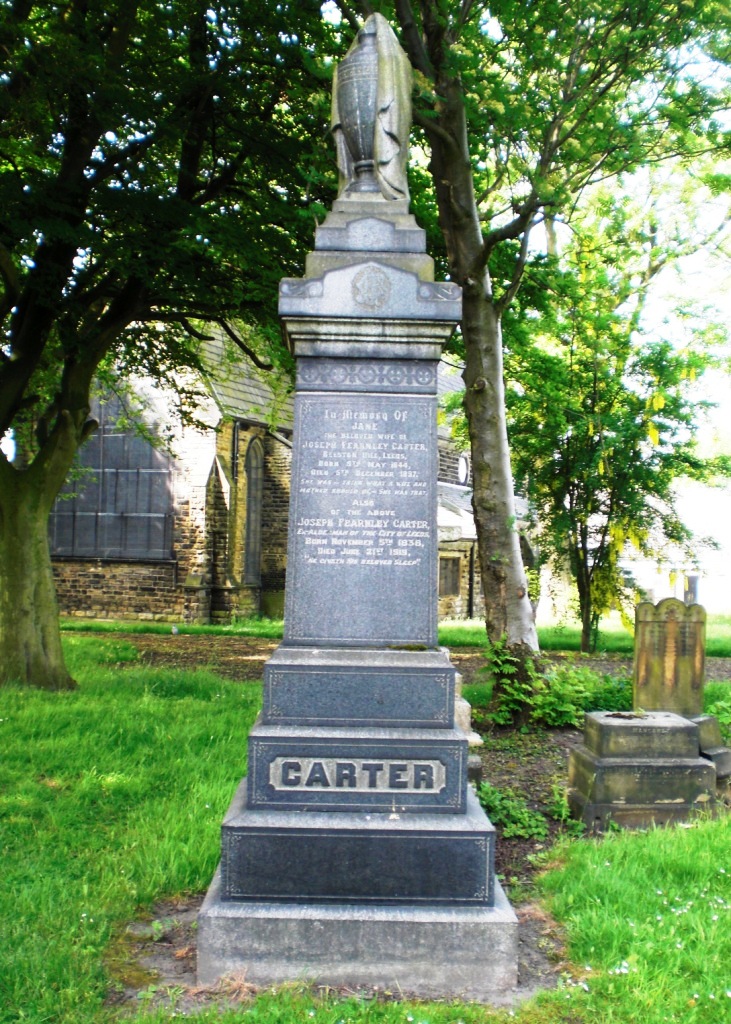
This house stands at the corner of Cross Flatts Park at the Beeston Road end.
It is a red brick end terrace house built in the latter part of the 19th and early part of the 20th century with a turret at the Park side that contains bay windows on the ground and second floors. At the rear was a garage, stables, and a hay loft and entry was from a back street.
The name plate is on the turret wall between the upper and lower windows, but now faded. The house was built on land released by the Low Moor Company of Bradford when mining ceased to be a financially viable proposition in Beeston at the end of the 19th century.
This is remembered in some street names in the area being named after mining officials – Hardy, Dawson, and Tempest. Lord Cranbrook, originally Gaythorne Hardy, was the son of one of the owners, hence the house name.
One of the early occupants of the house was Joseph Fearnley Carter who is shown in the 1906 Leeds Directory as living here. Joseph was born at Drub, Gomersal on 3 May 1839.
His father, James Carter was a Cordwainer (a man who makes new shoes out of new leather as opposed to a Cobbler who repairs shoes), his mother was Lydia Carter (nee Wigglesworth) who was born in Great Gomersal and who it is said was illiterate. They married in May 1825 at St. Peter’s Church in Birstall, they had seven children but one is thought to have died in infancy, Joseph was the youngest of the survivors.
Joseph’s name appears on every Census from 1841 to 1911 and when aged 22 he is listed as a ‘stone-mason’. He married Jane Longbottom of Hunsworth, the daughter of George Longbottom, Maltster. In 1871 he is listed as a Licensed Victualler at the Brunswick Hotel, 36 Vicar Lane, Leeds.
It was here in Leeds that he began to take an interest in politics and like a number of other local politicians he tried the Leeds Board of Guardians first and was elected to the Board in 1880. The 1881 and 1891 Census Returns show him as the Licensed Victualler at the Red House Inn, 92 Meadow Lane, Hunslet.
It was not until his third attempt that Joseph was to enter Leeds City Council as it then was; he failed in 1886 and 1887 but succeeded for the Conservatives in 1888 when he defeated the Liberal candidate Mr FW Batley. He was re-elected in the 1891, 1894, and 1897 elections.
In 1898 he was made an Alderman and served in this capacity until the Concordat between the Liberals and the Conservatives in 1904 when he and others elected to retire. This didn’t mean an end to his municipal career because in the following year he re-entered the Council as the representative of the South Ward after he had defeated the Liberal candidate Mr John Seddon by two votes, this was the only seat won from the Liberals in this election.
History repeated itself for Carter because in March 1906 when he was once again promoted to the Alderman Bench on the death of William Walker but he only held the position for two years before retiring in November 1910 because of increasing years and ill health.
For nearly 21 years Joseph had held the Chairmanship of the South Ward Conservative Association and during this time he had the satisfaction of seeing three Municipal seats in the South ward won by the Conservatives. He was clearly identified with the (Divisional) Conservative Association since its formation in 1863 and he held various positions, being at one time one of the Vice-Chairmen.
In the summer of 1911 he was presented on behalf of the Association at the great gathering in Middleton Park with a Testimonial in recognition of his valuable services to the Party.
Joseph’s Beeston connection is via the Old Punch Bowl pub on Town Street and the name FC Carter can be seen above the door in old photographs. In 1890 he pulled down the old pub and built the new Old Punch Bowl on the same site in 1892.
This new building complete with brew house was originally intended for Carters son, Frank Clarence Carter, but unfortunately the son met with a tragic accident while on his honeymoon at Lake Lucerne, Switzerland, where he drowned aged 34. His remains were returned to Beeston for burial in St Mary’s churchyard.

With his new pub came a small shopping parade of three shops one of which was James Boshells barbers shop; this is where Charles Blewitt had his moustache shaved off after murdering his wife Mary Ann in Star Fold, Beeston. The road behind the buildings was known as Carter Terrace, behind No.55 Town Street, Beeston.
The 1901 and 1911 Census show Joseph living at Cranbrook House, 219 Beeston Road and at this address he must have been a good employer because around 1905 a young woman in his service was married and he furnished their home from top to bottom as a wedding present.
Joseph was one of the more esteemed members of the Leeds Licensed Victuallers Association, although he had retired from business some years before. Joseph Fearnley Carter died on 21 June 1919 aged 80. He was buried at St Mary’s Church graveyard in Beeston where the family monument can still be seen. His wife Jane had died well before him on 5 December 1897, aged 53.
Another later occupant of the house was Percy Bickerdike, a Masseur and his wife Phyllis. Many of the rooms were adapted to receive patients who were in need of treatment and the bathroom was equipped with a spa for the use of patients. The bedroom over the front door was lead-lined, being intended for the use of X-ray equipment.
Outside the house there was a garage, stable, and hay loft which Percy put into use as a gymnasium and store for ointments and potions. The two front lawns were separated by a gate and an underground air raid bunker made of steel and some 16 tons of concrete, access to this was from the two cellars while an emergency exit from this was provided via a hatch into the gardens.
Unfortunately, before the lead-lined room was completed Percy died in 1936 at the age of 42. Phyllis, however, continued to live here until about 1992 when she is believed to have moved into sheltered accommodation.
The house was sold and then converted into flats, this seems to be the fate of these grand old buildings.



What an interesting article. I have often thought how grand that house would have been in its hay day. Ties in with the photo’s of the park with the ladies in their crinoline dresses looking at the aviary. Thank you for writing that.
Very interesting to read the history of this house and the people who lived there, I’m afraid a lot of these large homes are turning into HMO’s .Thank you for taking the time to research about Cranbrook House ,I enjoyed reading about it !
I remember that house well. My grandmother lived next door at 217
as a child I would occasionally wander next door to explore the the yard as it was a quick way into Cross Flatts Park.
The Duffey family lived lived at 215. I often I watched and gramps and My Duffy play “loud” games of chess. !
During the war years my grandmother’s house was always full with temporary wartime lodgers . I recall it was a lovely place with close access to the park.
Fond memories indeed !